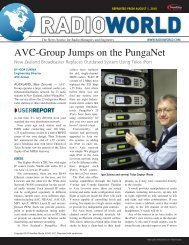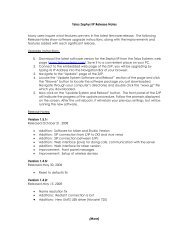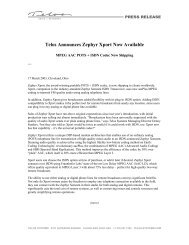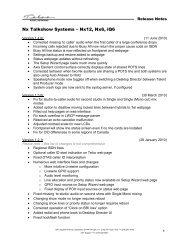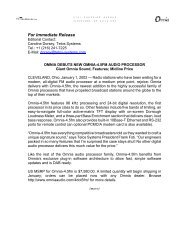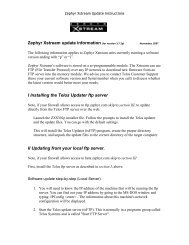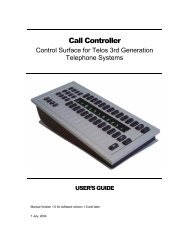NOW! 12-13 - Telos
NOW! 12-13 - Telos
NOW! 12-13 - Telos
Create successful ePaper yourself
Turn your PDF publications into a flip-book with our unique Google optimized e-Paper software.
LINEAR ACOUSTIC | LOUDNESS MANAGERS | APPLICATION ARTICLE<br />
108<br />
DELIVERING QUALITY SOUND<br />
A FAREWELL TO LOUDNESS<br />
Thank you, loudness. Thank you for your spikes, sudden bursts<br />
and consistent inconsistencies. Thank you for transforming<br />
serene, satisied television viewers into an angry, ear-cupping<br />
citizenry, banding together to complain to their governments.<br />
But most of all, thank you for inally causing the broadcast<br />
industry to bolt upright and recognize a seemingly obvious<br />
truth: TV is more than simply a picture. And for that, loudness<br />
deserves some gratitude.<br />
By reminding TV broadcasters of the importance of audio,<br />
loudness, in a way, has made TV quality better than it might<br />
have been.<br />
When broadcast engineers focus on the real audio issue – de-<br />
livering consistent quality sound – loudness becomes moot,<br />
consumers are contented, regulators draw back, producers<br />
can be satisied, and broadcasters are happy.<br />
It is also important to remember that while it is easy to blame<br />
loudness issues on commercial advertisements or other inter-<br />
stitials, it can also be the fault of the programs themselves. A<br />
train crash and explosion might be ine during a matinee but<br />
it is not going to go over very well at 3 in the morning with<br />
kids asleep.<br />
PLEASE MORE PEOPLE, MORE OF THE TIME<br />
Everyone wants your audio signal to be perfect, at least to<br />
their expectations. Who requires it the most? Is it the regulator?<br />
The station manager? The program producer? The consumer? In<br />
reality, it is all of the above but for different and sometimes<br />
opposing reasons.<br />
Each of these targets has their own benchmark for satisfac-<br />
tion. The station wants happy viewers and a happy regulator.<br />
The regulator wants no complaints from viewers.<br />
Ultimately then, the inal judge is the viewer. It is the viewers<br />
who create station ratings and thus a place for paid advertis-<br />
ing to be shown which generates revenue to buy programming<br />
and pay staff. It is the same viewers who will complain to the<br />
regulator when the audio is not right - especially when there<br />
are unexpected loudness shifts.<br />
The viewer wants consistent audio, then they will not complain<br />
to the regulator and the station is likely safe. How this is ac-<br />
complished, however, may not satisfy the program producer.<br />
COMPLIANCE OR QUALITY?<br />
Is it possible to regulate an audio signal to the point of being<br />
unlistenable? For some governments, nothing is impossible.<br />
Although regulators may specify both a loudness target and<br />
the method for measuring loudness, they will likely not react<br />
unless they receive viewer complaints. However, a regulated<br />
target and a metering speciication, if approached blindly, may<br />
result only in the meter being happy.<br />
Just like in the departed or soon to be departed days of ana-<br />
logue, devices can be installed at the end of the chain prior<br />
to transmission that raises or lowers gain depending on how<br />
much the loudness of the incoming audio varies from the tar-<br />
get. This is commonly referred to as Automatic Gain Control<br />
(AGC). AGC systems will more or less treat every shift similarly<br />
and will affect the good and the bad. Everything gets a little<br />
something whether it needs it or not.<br />
While there are many sophisticated (and some unsophisti-<br />
cated ways) to accomplish AGC, in reality there is no way for<br />
any machine, regardless of manufacturer, topology, or promise<br />
of magic outcome that can, in real time, know the difference<br />
between a good, intentional loudness shift and a bad, annoy-<br />
ing loudness shift. Certainly human generated commands and<br />
even metadata can be used to change or bypass processing for<br />
content that is believed to be good, but this involves a great<br />
deal of effort that has proven thus far not to have been exert-<br />
ed. Television mixers have long been used to the idea that what<br />
was transmitted via analogue means would be different than<br />
what they created and that was just the way it was. In today’s<br />
digital world, there is no technical reason why before and after<br />
cannot match. It happens when ilms mixed for the big screen<br />
are then transferred to DVD and the same audio coding system<br />
is used for 5.1 channel broadcasts.<br />
TAKE IT IN DOSES<br />
Since machines cannot automatically know the difference, a<br />
better approach is to separate the problem into smaller tasks:<br />
matching average loudness, managing transitions, and deliver-<br />
ing appropriate dynamic range.<br />
Taken separately, a much better result can be obtained. For<br />
example, to match the average loudness of programs, use of<br />
BS.1770 along with either manual or automatic control of the<br />
meter based on an anchor element such as dialogue, allows<br />
the overall average to be measured and then a simple overall<br />
one-time level scale to be applied so the target is achieved. This<br />
changes nothing about the content and preserves the intent<br />
of the producer.<br />
Matching average loudness of different pieces of content does<br />
not, however, solve jarring transitions. These occur at program<br />
boundaries and are the result of a mismatch of short term






